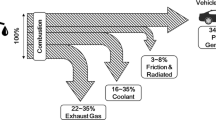Abstract
In engine coolers of off-highway vehicles, convective heat transfer at the coolant side limits both efficiency and performance density of the apparatus. Here, due to restrictions in construction and design, backwater areas and stagnation regions cannot be avoided. Those unwanted changes in flow characteristics are mainly triggered by flow deflections and sudden cross-sectional expansions. In application, mixtures of water and glysantine are used as appropriate coolants. Such coolants typically show an electrical conductivity of a few S/m. Coolant flow and convective heat transfer can then be controlled using Lorentz forces. These body forces are generated within the conducting fluid by the interactions of an electrical current density and a localized magnetic field, both of which are externally superimposed. In future application, this could be achieved by inserting electrodes in the cooler wall and a corresponding arrangement of permanent magnets. In this paper we perform numerical simulations of such magnetohydrodynamic flow in three model geometries that frequently appear in engine cooling applications: Carnot-Borda diffusor, 90° bend, and 180° bend. The simulations are carried out using the software package ANSYS Fluent. The present study demonstrates that, depending on the electromagnetic interaction parameter and the specific geometric arrangement of electrodes and magnetic field, Lorentz forces are suitable to break up eddy waters and separation zones and thus significantly increase convective heat transfer in these areas. Furthermore, the results show that hydraulic pressure losses can be reduced due to the pumping action of the Lorentz forces.






Similar content being viewed by others
References
Mahle Industrial Thermal Systems GmbH 2015, private communication
Batchelor GK (2000) An introduction to fluid mechanics. Cambridge Math. Library, Cambridge
Schlichting H (1967) Boundary layer theory. McGraw Hill, New York
Shercliff JA (1965) A textbook of magnetohydrodynamics. Pergamon Press, Oxford
Moreau R (1990) Magnetohydrodynamics. Kluwer Academic Publisher, Dordrecht
Davidson PA (2001) An introduction to magnetohydrodynamics. Cambridge University Press, Cambridge
Albrecht T, Stiller J, Metzkes H, Weier T, Gerbeth G (2013) Electromagnetic flow control in poor conductors. Eur Phys J 220:275–285
Jackson JD (1999) Classical electrodynamics. Wiley, New York
ANSYS® Academic Research (2015) Release 16.2, ANSYS Fluent Advanced ADD-On Modules, p. 359 ff., ANSYS, Inc.
Mischer T (2016) Thermodynamische Analyse und numerische Simulation zur elektromagnetischen Beeinflussung der Motorkühlung. M. Sc. Thesis, Technische Universität Ilmenau
VDI-Wärmeatlas (2015) VDI e.V. (eds.), Springer-Verlag Berlin Heidelberg
Idelchik IE (2005) Handbook of hydraulic resistance. Jaico Publishing House, Mumbai
Newman BG (1961) Boundary layer and flow control. Pergamon Press, New York
Acknowledgements
The authors acknowledge support from Deutsche Forschungsgemeinschaft (DFG) within the frame of the Research Training Group “Lorentz force velocity and Lorentz force eddy current testing” under grant GRK-1567. We thank M.Sc. Thomas Mischer for carrying out the simulations.
Author information
Authors and Affiliations
Corresponding author
Rights and permissions
About this article
Cite this article
Karcher, C., Kühndel, J. Convective heat transfer in engine coolers influenced by electromagnetic fields. Heat Mass Transfer 54, 2599–2605 (2018). https://doi.org/10.1007/s00231-017-2130-4
Received:
Accepted:
Published:
Issue Date:
DOI: https://doi.org/10.1007/s00231-017-2130-4




